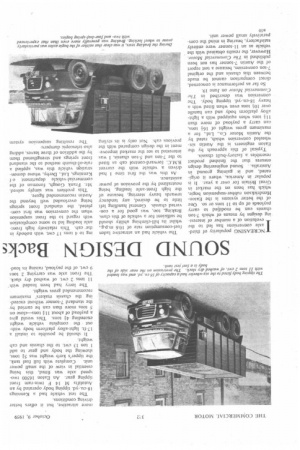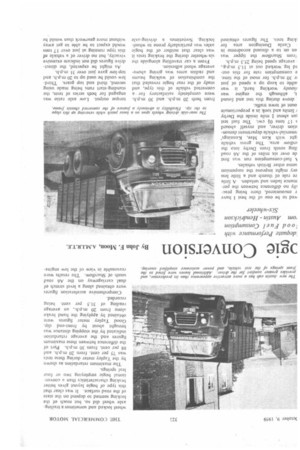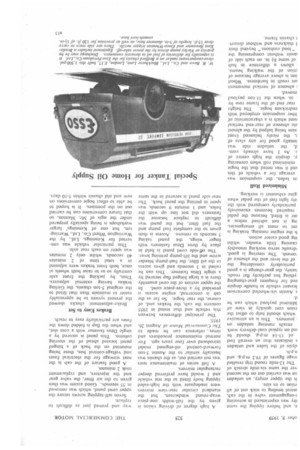SOUND DESIGN Backs
Page 44

Page 45

Page 46

Page 47

If you've noticed an error in this article please click here to report it so we can fix it.
Dgie Conversion By John F. Moon, A.M.I.R.T.E.
INCREASING popularity of thirdaxle conversions has led to the evolution of a number of interesting designs by means of which 7-ton chassis can be modified to carry payloads of up to 11 tons or so. One of the better systems is the EatonHendrickson rubber-suspension bogie, which has been on the market in Great Britain for over a year. It is popular in America, where it originated, and is gaining ground in Australia. Sound engineering design ensures that the finished product resembles a factory-built chassis.
Typical of this approach by the Eaton engineers is the Austin sixwheeled conversion which, rated by the Austin Motor Co., Ltd., for a maximum gross weight of 164 tons, can carry a payload of more than 11-4 tons when equipped with a lightalloy platform body and can handle over 104 tons even when fitted with a heavy 18-cu.-yd. tipping body. The conversion was described in The Commercial Motor on June 19.
So far as performance is concerned, direct comparison cannot be made between this chassis and the original 7-ton conversion, because a test report of the Austin 7-tormer has not been published in The Commercial Motor. However, the results obtained with the vehicle as an 11-tonner were entirely satisfactory, bearing in mind the comparatively small power unit.
B10 The vehicle had an attractive laden fuel-consumption rate of 10.6 m.p.g., whilst its hill-climbing ability should be sufficient for a vehicle of this class. Braking, too, was good for a converted chassis. General handling left little to be desired, any tendency towards heavy steering, because of the high front-axle loading, being neutralized by the provision of power assistance.
As this was the first time 1 had driven a vehicle with the current B.M.C. forward-control cab as fitted to the 7-ton and 5-ton chassis, I was interested to see the marked improvement in the design compared with the previous cab. Not only is its styling
more attractive, but it offers better driving conditions.
The test vehicle had a Kennings I8-cu.-yd. tipping body operated by an Autolifts M 14 F twin-ram front tipping gear. An Eaton 16500 twospeed axle was fitted, this being essential in view of the small power unit. Complete with full fuel tank, the tipper's kerb weight was 51 tons, showing the body and gear to add 1 ton 13 cwt. to the chassis and cab weight.
It should be possible to install a 17-ft. light-alloy platform body without the complete vehicle weight exceeding 44 tons. This would give a payload of about 114 tons—close on 5 tans more than can be carried by the standard 7-tonner without exceeding the chassis makers' maximum recommended gross weight,
The lorry had been loaded with 11 tons 2 cwt. of washed dry slack. The front axle was carrying 2 tons 9 cwt. of the payload, raising its load Ing to 4 tons 17 cwt. with nobody in thecab. This relatively high frontaxle loading led to some complication with regard to the front suspension when the conversion was first completed, the standard front springs being overloaded well beyond the Austin recommended figure.
This problem was simply solved. Mr. Frank Gough, foreman of the commercial-vehicle department o f Kennings, Ltd.. Derby, whose demonstration vehicle this was, applied a rule-of-thumb method to the standard front springs and strengthened them by the addition of three leaves, adding also telescopic dampers: The resulting suspension system Ned to be one of the best I have r encountered, there being pracilly no difference between the permance laden and unladen. A little re rule of thumb and a little less ory might improve the suspension some other British vehicles.
k fuel-consumption run was first de over six miles of the A6 road Jing south from Derby into the trdlow area. The gross vehicle ight with Ken Mee, Kennings' nmercial-vehicle department demonttion driver, and myself aboard s 17 tons 01 cwt. The fuel test ;an about mile inside the Derby r limits and took in a proportionate ount of town traffic.
drove during this test and found t, although the engine was hously working hard, it was ;sible to keep up a speed of just :I30 m.p.h. for most of the time. e consumption rate for this outrd leg . worked out at 11.5 m.p.g., average speed being 25.3, m.p.h. r o m Shardlow the tipper was .en on to a disused aerodrome in . Castle Donington area for Lking tests. The figures obtained
from both 20 m.p.h. and 30 m.p.h. were completely satisfactory for . a converted vehicle of this type, and study of the rear bogie revealed that the combination of walking beams and radius arms was giving aboveaverage wheel adhesion.
From a car travelling alongside the six-wheeler during the braking tests it was clear that neither of the bogie axles was particularly prone to wheellocking. Sometimes a driving-axle wheel locked and sometimes 'a trailing axle wheel did so, but much of the locking seemed to depend on the state of the road surface. It was clear that this type of bogie layout gives better braking characteristics than a conventional bogie employing two or four leaf springs.
The maximum retardation as shown by the Tapley meter during these tests was 75 per cent. from 20 m.p.h. and 88 per cent. from 30 m.p.h. Part of the difference between these maximum figures and the average retardation indicated by the stopping distance was brought about by front-end dip. Good Tapley meter figures were obtained by applying the hand brake alone from 20 m.p.h., an average reading of 31.5 per cent. being recorded.
Comprehensive acceleration figures were obtained along a level stretch of dual carriageway on the A6 road south of Shardlow. The results were reasonable in view of the low engine torque output. Low axle ratio was engaged for both series of tests, the standing-start runs being made using second, third and top gears. Thirdlow could be used up to 20 m.p.h. and top-low gave just over 31 m.p.h.
As might be expected, the directdrive figures did not indicate excessive vivacity, but no driver of a vehicle of this type running at just over 17 tons would expect to be able to get away without more gearwork than would be necessary with the standard 7-ton chassis.
The hill-climb test for temperature rise and brake fade was conducted up the mile-long hill known as Bondgate, which runs through the centre of Castle Donington. This has an average gradient in the region of 1 in 16 and the ascent was made in an ambient temperature of 63° F.
The climb occupied 51 minutes and for most of this time second-high and third-low were engaged. The lowest combination of ratios employed was first-high, which was used for approximately a minute, during which time the minimum road speed was 9 m.p.h.
Before making the climb the radiator coolant temperature was found to be 149 F., and the same temperature was recorded at the top of the hill. Obviously the thermostat had opened fully and the high fan speed resulting from the use of high engine revolutions in the lower ratios had served to keep the power unit well cooled.
To check for brake-fade resistance, the six-wheeler was coasted down the hill in neutral at a speed of approximately 20 m.p.h„ the descent lasting nearly 3 minutes. On the way down the engine was kept idling, but as there is no reservoir in the braking system little servo effect was being obtained after the first few applications of the pedal.
Thus the full-pressure stop made at the bottom of the hill—which produced a Tapley meter figure of 32 per cent. from 20 m.p.h.—was made with no servo effect. Had the vehicle been equipped with a reservoir, so that full servo vacuum had been available, there would have been little or no reduction in maximum braking efficiency. As it was, the brakes were showing no signs of smoking or smell after this stop and the only impediment to a higher figure was the effort that could be applied to the brake pedal.
• I was given to understand by Mr. L. Maxton, Kennings' commercial-vehicle sales manager, that future conversions of this chassis are to incorporate a vacuum reservoir to give a reserve of braking power with a dead or idling engine.
Having turned the six-wheeler round, I took it up a 1-in-9 gradient known as Hillside, which runs off to the left from Bondgate. On this slope the vehicle was stopped and the hand brake held it safely without the need for help from the foot brake. A restart was only just accomplished in bottom gear, low axle ratio, the engine working at the top limit of its power. When facing down the hill it was impossible to restart in reverse-low, the slight difference between the bottom and reverse ratios of the B.M.C. gearbox being critical.
The return to Derby was made the subject of a second fuel test over the same stretch of road. On this occasion the six miles were covered at an average speed of 24.5 m.p.h., the use of 5 pints of fuel indicating a consumption rate of 9.8 m.p.g. Combination of the two results gave an average figure of 10.6 m.p.g.
At the end of the first day's testing the borrowed payload was discharged at a coal tip. To approach this tip it was necessary to reverse up a slight gradient for a matter of some 20 yd. or so and at one stage the near-side driving wheel spun because of a mound of loose coal dust. I was able to " jump " the tipper past this obstruction, however, and the rest of the slope was climbed steadily.
As usual with British tipping bodies, the tail-gate lock was difficult to e, and before tipping the same ilty was experienced in actuating 1-engagement valve in the cab, mtrol tending to stick out of all Ttion to its size.
h the tipper empty, an unladen :st was carried out on the second ver the same six-mile stretch of The 12-mile round trip resulted :rage figures of 19.2 m.p.g. and n.p.h.
ilysis of the laden and unladen s indicates that an overall fuel of 13-14 m.p.g. should be led on typical coal-delivery work entails running unladen on journeys. This is an attractive which should help to offset the rsion cost quickly in view of klitional payload which can be d.
s Austin six-wheeled conversion leasant vehicle to handle despite eed for frequent gear-changing ything but perfectly flat roads. nately, the gear-change is a good particularly considering the of the lever and the absence of -omesh. The steering is good, /draulic servo working smoothly causing little wander, whilst ing good castor action.
h the engine running, braking is ent to meet all emergencies. ing is not advised unless a oir is fitted, because the pedal required becomes excessively particularly compared with the ely light feel of the pedal when !gine exhauster is working.
Minimized Roll :n laden, the suspension was average for a vehicle of this ind it was noted that the bogie minimized roll when cornering y, despite the high centre of Ir. As I have already cornd, the unladen ride was ionally good for any class of
the nicely balanced front sion being helped by the almost ete absence of rear-end vertical nent which is a characteristic of bber suspension employed with endrickson bogie. The height rear end of the frame rose by in. when the 11-ton payload moved.
; absence of vertical movement tot result in harshness. Wheel ion is above average because of ztion of the walking beams. allows a difference in hub of some 81 in. on each side of iassis without compressing the "load cushions" beyond their 1 thickness and without distort: chassis frame. A high degree of driving vision is given by the full-width one-piece wrap-round windscreen, but the standard circular rear-view mirrors were inadequate with the high-sided tipping body fitted to the test vehicle and I would have preferred deeper rectangular mirrors.
A full series of maintenance tests was not carried out, as the chassis was basically similar to the Austin 5-ton forward-control oil-engined model introduced over four years ago. For normal maintenance procedures and times. reference can be made to The Commercial Motor of August 26. 1955.
The principal differences between this vehicle and that tested in 1955 concern the cab, the brakes and, of course, the rear bogie. So far as the cab is concerned, engine access is provided by. a three-piece cowl. In the upper section of the cowl assembly there is a large hinged flap secured by a single Dzus fastener. This can be raised in 3 seconds and gives access to the oil filler, the fuel-pump bleeder screw and the lift-pump priming lever.
The off-side cowl panel is held in place by three Dzus fasteners with finger wings, the panel taking 5 seconds to remove. Access is then given to the complete fuel pump and the fuel filter, but the panel was difficult to replace because the fasteners did not line up with the holes, and 1 minute 9 seconds was spent in putting the panel back. The near-side panel is secured in the same way and proved just as difficult to replace.
Seven self-tapping screws secure the upper cowl panel, which was removed in 55 seconds.. Good access was then given to the air filter, the valve gear and the injectors, and replacement took 2 minutes.
A good feature of the cab is the neat stowage for the electrical fuses and voltage-control box, these being mounted on the back of a hinged panel located ahead of the steering column. This panel is secured by a single Dzus fastener with a coin slot, and when the flap is folded down the fuses are particularly easy to reach.
Brakes Easy to Set
Brake-adjustment checks showed the present system to be appreciably easier to maintain than that fitted to the original 5-ton chassis, the Girling brakes having external adjusters. Thus, by jacking the front axle centrally so as to raise both wheels at once, both front brakes were adjusted in a total time of 2 minutes 40 seconds, whilst only 2 minutes was spent on each rear axle.
This particular vehicle was converted for Kennings, Ltd., by the Warrington Wheel Co., Ltd., Warrington, but one of Kennings' larger workshops is being specially prepared under the.iegis of Mr. Maxton, so that future conversions can be carried out on the premises. It is hoped to be able to effect bogie conversions on new and old chassis within 5-10 days.




































































































